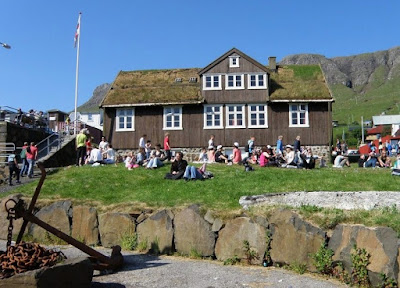Tvøroyri is the main village on the island of Suðuroy, the southernmost of the Faroë Islands, on the North Atlantic.
The small fishing town is located at the bottom of the fiord Trongisvágsfjørður.
Tvøroyri sits like a ribbon-shaped urban agglomeration along the north shore.
The historic waterfront of Tvøroyri, at left, faces the main harbour across the fiord.
The setting is typical of a nordic fiord.
Tvøroyri, Sudoroy, Faroë Islands
Coordinates: 61° 33′ N, 6° 48′ W
(sub-arctic)
Population: ~ 1750
The old warfs have been restored, as they are the village's first impression.
This is now a leisure area, quite lively in summer.
The M/S Thorshavn (built in oak and beech, Denmark, 1940) now serving tourist cruises.
The Sail Loft (Seglloftið)
This was the old sail making house.
As part of of the old merchant port, the building is now a cultural venue, as are the black painted old warfs.
The most famous window in Tvøroyri...
... and its view: the old Krambúðin.
Krambúðin
Krambúð means shop in Faroese.
The first house to be built in Tvøroyri was the old shop, which the Royal Trading Monopoly built in 1836. Since 1856 this building has been known as Krambuðin (grocery shop).
Tvøroyri Museum Doktarahúsið
In the vicinity of the quay, the local maritime museum is installed in the old doctor's surgery, kept authentic with a grass roof.
Doktarahúsið, the Doctor's House.
This museum tells the local history of Tvøroyri and the fiord area around. It is a historical and maritime museum.
The building is one of the first built in Tvøroyri, from 1852.
Cast iron work
Traditional faroese dress and jewelry.
Gallari Oyggin
The Gallari Oyggin ('Island Gallery') is situated on the main street in Tvøroyri. There are sculptures in the garden and on the parking spot, opposite the gallery.
The owner is Palle Julsgart, who is an artist himself. The Oyggin Gallery has shifting exhibitions with guest exhibitors from the Faroe Islands and from other countries. The café in the gallery serves light dishes and drinks.
Site:
http://visitfaroeislands.com/place/gallery-oyggin/#sthash.iSiJX7QY.dpuf
The shop
Tangabúðin, Sjógøta (Opposite of the Art Gallery Oyggin).
Owned also by Palle Julsgart, this cosy little shop opposite of the Art Gallery sells gifts, books and framed works from local artists. On the square next to the shop there are several sculptures.
Tvøroyri church
On the east side of the village, high on a hillside over of the town, and visible from far away.
The prebuilt wooden church was shipped to Tvøroyri and assembled in 1907.
The fiord and the water festival Jóansøka
Tvøroyri harbour is protected as heritage but also for its strategic value. Twelve fishing vessels have their home port here. As measured by the fleet, this is the fifth most important port of the North Atlantic archipelago.
The island's traditional boat, called 'Smyril'.
Each year Tvøroyri and Vágur take turns with the celebration of a midsummer festival, called Jóansøka, the St John's feast.
Several proofs of rowing take place in traditional smyril boats.
The modern ferry, baptised Smyril V, watchimg protectively a Smyrill race.
This festival takes place every year on the weekend that falls closest to June 24 (St. John's day).
Jóansøka in uptown Tvøroyri.
The daily ferry from Tórshavn docks at Drelnes, opposite on the south shore of the fjord. The crossing from Tórshavn takes about a half hour with the new ferry Smyril V. The ferry serves not only passenger transport, but also trade with the outside world.
The new ferry sailing past Tvøroyri.
The winter snow brings a different look to the town and the fiord:
The church, above the town's main street.
Trongisvagur river mouth, into the fiord.
The Park of Trongisvágur
A popular excursion destination is the forest Viðarlundin í Trongisvági , one of the largest of the Faroë Islands, which are mostly treeless. It consists mainly of spruce, pine and ash and is located about 1 km west of the town.
The Faroese word Viðarlundin means little forest or little plantation.
The Faroë Islands, with their moist cool climate and salty air, are not suitable for the prosperity of trees; the soil crumb is also relatively thin and offers little support.
The road around Suðuroy offers some Faroë typical panoramics - a treeless but green covered land above large sea views.
One of the finest views is the Lilla Dímun island, close to the east coast of Suðuroy.
The west coast is quite more wild and rugged.























































